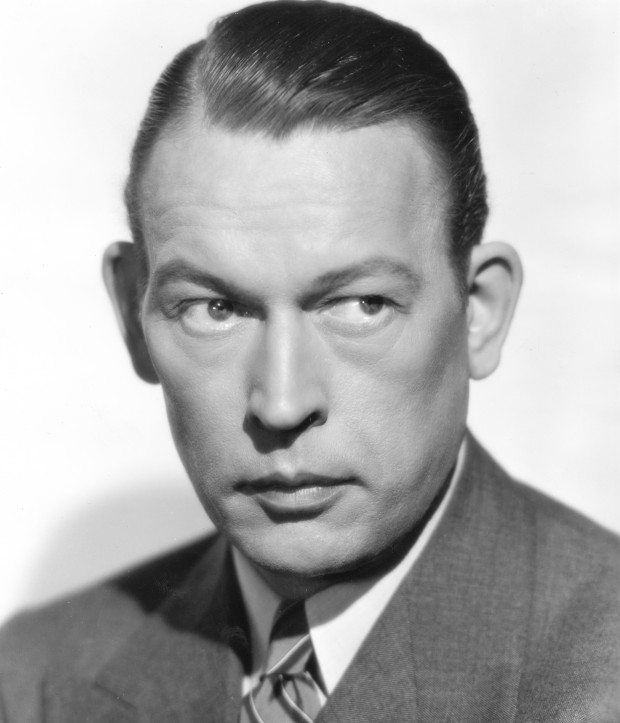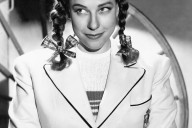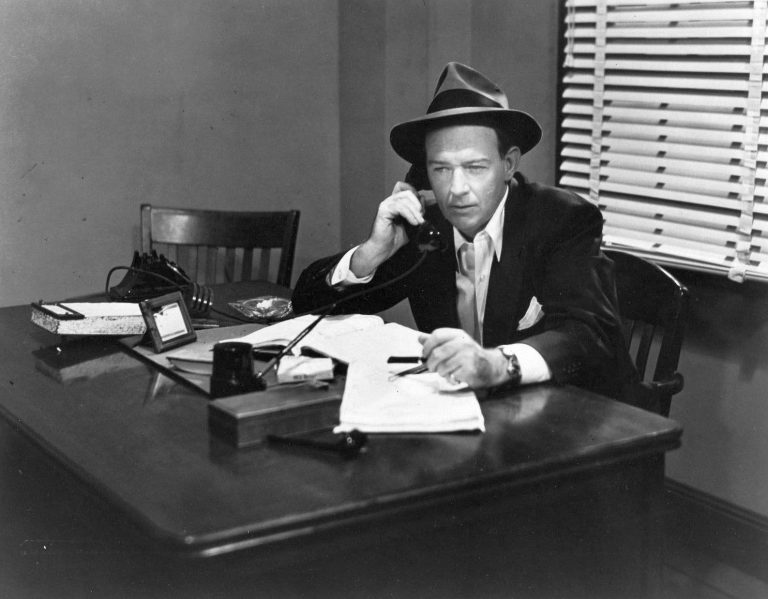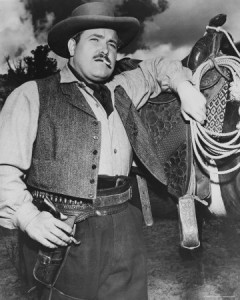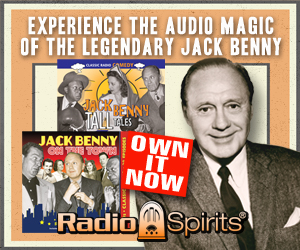By Elizabeth McLeod
It was created out of necessity, and it became a cultural touchstone of the 1940’s: a ten-minute segment of a popular comedy-variety program that featured some of the most incisive commentary ever offered about the passing scene of wartime and early postwar America. It remains today as one of the most memorable legacies of the Radio Era.
Fred Allen wasn’t a man who liked change. He’d been doing a weekly hour-long radio program for more than eight years by 1942, and while he grumbled about the endless grind of his work routine, in his own way he found that routine comfortable. Like most New Englanders of his generation, Allen was set in his ways — and once he established a routine he preferred to stick with it. But, the handwriting had long been on the wall for the hour-long comedy-variety series — by the spring of 1942, Allen’s was the last such program on the air. Network time was becoming too expensive to maintain such series, and the coming of America’s involvement in the Second World War only made matters worse. Allen’s sponsor, the Texas Company, made its money selling gasoline — and when gasoline was rationed in the Northeast in May of 1942, the fate of the hour-long Texaco Star Theatre was sealed. Beginning in the fall, the program would be slashed to thirty minutes. Like it or not, Fred Allen would have to adjust to a new routine.
One of the signature elements of Allen’s hour-long show had long been the weekly newsreel segment — in which a parade of absurd characters would be interviewed for their take on obscure news events of the moment. Allen’s supporting cast, best known as The Mighty Allen Art Players, specialized in the interpretation of these roles, presenting them in every dialect possible. Allen’s satirical pencil was at its sharpest in creating their commentary. The newsreel was continued in a somewhat condensed form for the first two months of the new half-hour series, but Allen, under stress from a difficult adaptation to the new format, began thinking about the segment in different terms. Instead of an ever-changing cast of oddballs, why not employ a sequence of regular characters, whose recurring traits and catchphrases might help to simplify the process of writing and production? Allen had already benefited from the introduction of Fallstaff Openshaw, the rancid poet portrayed to perfection by Alan Reed, and more characters along the same line would be just the thing to give the newsreel segment a facelift.
Newspaper columnist O.O. McIntyre, a longtime fixture in the pages of the New York Evening Journal and Journal-American, provided additional inspiration. When stuck for ideas, McIntyre frequently turned to a device he called “Thoughts While Strolling” — contrived interviews with colorful New York street characters on popular topics of the day. Allen merged this idea with his own concept to create a theoretical cul-de-sac along which he might wander in his own search for cultural illumination — a street he dubbed “Allen’s Alley.”
To populate the Alley, Allen turned to his Art Players, creating characters based around each performer’s most accomplished dialect. For sharp-voiced John Brown, Allen created John Doe, the Average Man — a put-upon Brooklynite who seemed to function in a constant state of agitation. For the woman he considered the “greatest female dialectician ever to work in radio,” the diminutive, versatile Minerva Pious, Allen embodied her thick Yiddish dialect in the person of Mrs. Nussbaum. For Charles Cantor, specialist in all characters dopey, Allen created Socrates Mulligan, giving permanent form to a character known around the Allen offices as “the low dope.” And, Alan Reed was already on the scene as Fallstaff Openshaw, whose seedy rhymes offered the perfect cap to the weekly Alley routine.
Such were the initial residents of what quickly became radio’s most famous side street. Allen’s questions for this threadbare quartet ran the gamut from serious to silly — one week Allen might address real-life concerns about rationing or the progress of the war, while in another visit he might poll the Alley residents about whether President Roosevelt or Mayor LaGuardia makes the better cup of coffee. “Allen’s Alley” managed to preserve the best of the ever-changing newsreel segments while giving the program, for the first time in its history, a cast of regular, familiar characters.
That cast spent its first few years in a state of minor fluctuation. When John Brown moved to Hollywood in 1943, he was replaced by Jack Smart. A veteran of Allen’s 1930’s cast, he took on the role of the bloviating Senator Bloat, whose “Bloat Bill” would solve whatever problem happened to need solving. When Minerva Pious was otherwise obligated, veteran dialectician Elsie Mae Gordon stepped into the breach as the Zasu Pitts-on-helium-voiced Mrs. Prawn, while Charlie Cantor unfurled his own smoked-salmon accent as Mrs. Nussbaum’s husband Pierre. Actor/writer Pat C. Flick turned up now and then as the tumble-tongued Greek, Pablo Itthepitches. Alan Reed, as Falstaff, remained a constant throughout this period.
The original Alley came to an end when Allen himself took a year off from the program on the advice of his doctor — his blood pressure, never healthy, was approaching dangerous levels, and a less-stressful life was the medical prescription. Allen took advantage of the interval to make a movie, the unforgettable It’s In The Bag, which featured a cameo appearance by Alley stalwart Min Pious in character as Mrs. Nussbaum. Fortunately, he managed to recover enough of his health to return to radio in 1945. By that time, however, some changes needed to be made. Charlie Cantor was fully committed to Duffy’s Tavern, where Socrates Mulligan had turned into Clifton Finnegan. Jack Smart, the future “Fat Man,” had returned to Hollywood to continue his movie and radio career there. Although Pious and Reed remained in New York to work on the new Allen series, the Alley needed to be fleshed out.
Allen found what he needed in the cast of The Alan Young Show. Young, an up and coming Canadian comic had become the Bright Young Man of radio during Allen’s absence from the air. Allen himself had become a fan of the program — which aired for his old sponsor, Bristol-Meyers, used his former orchestra leader, Peter Van Steeden, and had an Allen-esque quirkiness in its use of absurd supporting characters. Among the characters on the show were a blowhard politician (played by Mercury Theatre veteran Kenny Delmar), and a querulous old man (voiced by radio’s finest impersonator of querulous old men, Maine-born Parker Fennelly). When the agency producing Young’s show — an agency with which Allen himself had had his share of disputes — objected to both of these characters and ordered them dropped from the program, Fred Allen immediately contacted Young’s producer and secured permission to add them to his own series.
Delmar’s Southern-fried politico became Senator Beauregard Claghorn, the Southernest man who ever lived…so southern that he wouldn’t drink a drop of water unless it was served in a Dixie cup. And, Fennelly’s laconic old rustic, a character he had been portraying on the air for twenty years by this point, was christened Titus Moody. With Pious returning as Mrs. Nussbaum and Alan Reed continuing as Falstaff Openshaw, the Alley returned to the air in full vigor in the fall of 1945. When Reed left the program — with both Allen’s blessing and the rights to use the Openshaw character in his own projects — veteran impressionist Peter Donald stepped in to fill the final Alley slot as bibulous Irish lout Ajax Cassidy, a character Allen had known only too well from his real-life Dorchester childhood. Claghorn to Moody to Nussbaum to Cassidy became the Alley’s best-remembered configuration, remaining intact for most of the program’s remaining run. Allen tried to avoid wearing the characters out by occasionally slipping in replacements. During a hiatus for Senator Claghorn, Delmar appeared as the Russian caricature Sergei Stroganoff, a character abruptly dropped when a real-life Sergei Stroganoff complained. And, Ajax Cassidy took a brief vacation — perhaps motivated by complaints from Irish organizations — while Peter Donald appeared as the Openshaw surrogate Humphrey Titter. Later, even the seedy urban imagery of the Alley itself was replaced when new sponsor Ford Motors insisted Allen call the segment “a walk down Main Street.”
But, Allen’s Alley remained firmly fixed in the minds of the audience as the definitive feature of Fred Allen’s program, even after the series finally ended in 1949. Allen did his best to keep the concept alive in his brief, abortive stabs at television. Delmar, Fennelly, Pious and Donald accompanied him in these attempts, at first in costume as their traditional characters, and later as the voices of hand puppets. But, the Alley was purely a construct of radio, a cul-de-sac rooted entirely in the imagination of the audience, and Allen finally realized it could not be successfully translated to a visual form. So, Allen’s Alley passed from the scene, but it was never forgotten. To this day, a short spur off Tremont Street, in the heart of Boston’s theatrical district where Fred Allen began his show business career, bears the name of “Allen’s Alley.”
Copyright 2012 Elizabeth McLeod and RSPT LLC. All rights reserved.

